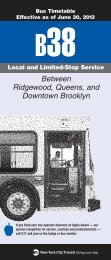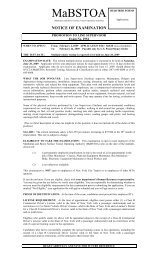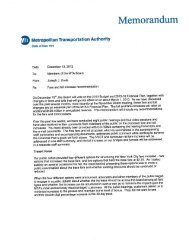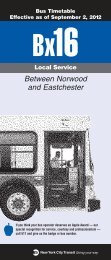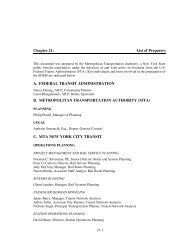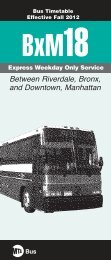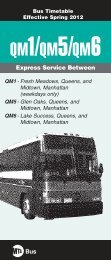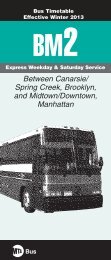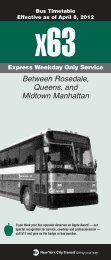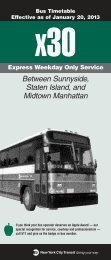Greening Mass Transit & Metro Regions: The Final Report - MTA
Greening Mass Transit & Metro Regions: The Final Report - MTA
Greening Mass Transit & Metro Regions: The Final Report - MTA
You also want an ePaper? Increase the reach of your titles
YUMPU automatically turns print PDFs into web optimized ePapers that Google loves.
Cities well-suited to a Bike Share program have:<br />
• the density and mixed land use necessary to generate sufficient ridership<br />
• relatively flat terrain<br />
• an on-street bicycle network, including lanes, bicycle boulevards, and slow streets (e.g. every 2-3 Avenues offer protected<br />
cycling routes, residential street speed limits reduced to 15 mph)<br />
Bike Share is NOT:<br />
• a drain on the city budget (it potentially generates revenue)<br />
• free bike rentals (its purpose is public transportation and it integrates with other transit modes)<br />
• a network of bicycle rental locations (the system is automated and capitalizes on low barriers to entry)<br />
• a program only for pre-existing bicycle enthusiasts (Bike Share in Paris increased cycling by 168 percent in one year and<br />
brought bicycle mode share from less than 1 percent to almost 5 percent in the same amount of time)<br />
• a detriment to private bike sales and traditional bike rentals (in cities like Paris it has increased both)<br />
Impact:<br />
By placing stations strategically – at transit hubs and other popular origins and destinations – Bike Share transforms<br />
urban mobility by adding a flexible, cost-effective and sustainable transportation option to the existing public transportation<br />
network in a city. Public bike system trips in Europe have replaced bus or subway trips by 34 to 65 percent, depending on<br />
the city, and car or motorcycle trips by 6 to 10 percent. In Paris cycling increased by 168 percent in only the first year of the<br />
bike share program and the bicycle mode share went from less than 1% to almost 5% in the same amount of time.<br />
Bike Share holds huge potential to free-up much needed space on existing public transit modes and to favorably change<br />
urban commuter behavior as part of a larger plan to reduce carbon emissions, calm traffic to enhance street safety and<br />
improve public health.<br />
Smart Growth/TOD - Case Studies<br />
<strong>Metro</strong>-North Case Studies - New York<br />
Beacon:<br />
Bike Share programs increase public transportation options at a relatively low cost to the city. Any registered user can<br />
"borrow" a bike from a station for a nominal fee and return it to any other station in the system. Bike Share should not<br />
be confused with free bike rental, however, because users typically pay an annual fee, borrow and return bikes to multiple<br />
locations, and ride mainly for transportation, not for recreation. While users may take the bikes for as long as they need,<br />
the usage charge for the time incrementally increases to encourage short, transit-oriented trips (the first half-hour should<br />
be free to encourage short trips and reduce barriers of entry).<br />
A policy to promote transit-oriented development (TOD) as a way of increasing ridership, supporting efficient land use, and<br />
leveraging public assets reflects the proactive role <strong>Metro</strong>-North Railroad plays in encouraging development in and around<br />
its stations. At Beacon Station, <strong>Metro</strong>-North recognized the importance of a broad-based outreach process in achieving a<br />
region-wide perspective while understanding the role of the station within the community.<br />
In 2002 <strong>Metro</strong>-North initiated and facilitated a community planning charrette for a Station Area Master Plan that<br />
would improve station access at Beacon. <strong>The</strong> charrette engaged more than 20 key stakeholders, including the town,<br />
county, federal and state agencies, and major environmental, cultural, and local groups. This laid the groundwork for<br />
continued planning over the next two years.<br />
A public workshop was later held to gather additional feedback on three alternatives developed from the charrette.<br />
Comments from the stakeholder groups and the public identified a preferred option and ongoing planning meetings refined<br />
the Master Plan to achieve consensus on the final version.<br />
In 2004 a short-term improvement plan and a long-term Master Plan for the station area was finalized. <strong>The</strong> long-term<br />
Master Plan included a TOD design to improve service for current <strong>Metro</strong>-North customers and to generate economic<br />
growth in the City of Beacon. <strong>The</strong> key element of the Master Plan was a self-sustaining mixed-use TOD that would act as<br />
a gateway to the Beacon waterfront. <strong>The</strong> TOD element seeks to:<br />
• Promote smart-growth principles including improved access to public transit, increased development density with lower<br />
parking requirements, and commercial and cultural activities.<br />
87



